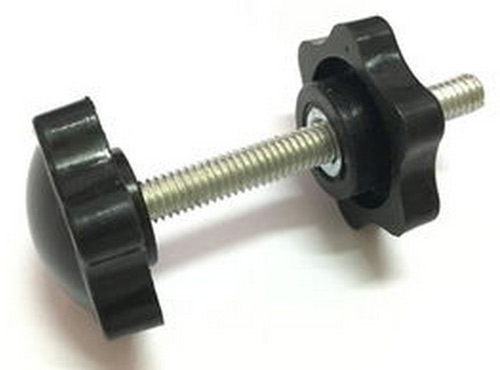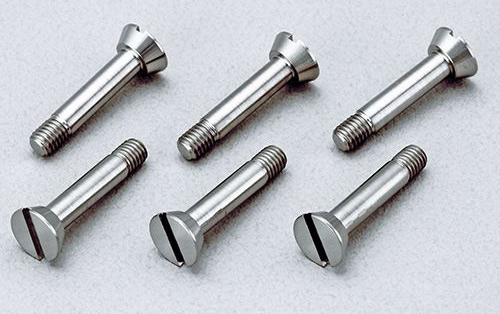One end of the fastener is formed into a bearing surface formed by an enlarged portion. The so-called bearing surface refers to the part that supports or locates the joint, and usually the bearing is used to load and unload the screw. There are two basic types of bearing surface, the flat bearing surface (perpendicular to the knot part) and the tapered bearing surface (forming the angle with the knot part). In most cases, the service is to withstand the load force acting on the knot. In addition to continuing the same function of the flat deck, the latter can also be used for positioning. A knot with a tapered bearing is usually referred to as a countersunk head. The different applications of the head shape depend initially on the function of the deck and the ability of the head to transmit torque.

Flat bearing bolt
First, the types of bolts and bolts commonly used for flat bearing surfaces are different :
Flat head: a new design that can replace the round head and the mushroom head. The head has a low diameter and a high peripheral edge of the outer circumference of the head, which makes it play a high-intensity torque, and the head is in the head shape. There are minor differences.
Round head: It is the most commonly used head shape in the past.
Top column head: The standard flat dome head has a smaller diameter than the round head, but it is relatively high due to the groove depth. The smaller diameter increases the pressure acting on the small area and can be tightly combined with the flange and the raised surface. . Since they are used in the drilling molds provided for the purpose of ensuring concentration, they can be successfully applied to the holes of the inner drilling.
Wide-width head: The most common application in electrical appliances and tape recorders due to the incision under the head and the weakening of the wear on the wires. The mid-lower head type is more attractive for its fuller bearing. Type of design.
Large round head: also known as the elliptical top wide side head, is a low-profile, cleverly designed large-diameter head. It can be used to cover metal plate holes with larger diameters when the combined tolerances of the additional action allow. It is also advisable to use a flat head instead.
Slotted head type: This is a creative anti-loose type. Once the combination is not easy to remove, it can be started with a standard standard screwdriver. This simple design can often solve the cost problem in the portfolio, increase the number of production, and create amazing economic benefits for the manufacturing process.
Hexagon socket head: A knot with a wrench head height and a hexagonal head size. The hexagon is completely formed by the cold mold of the counter hole, and there is a distinct depression at the top of the head.
Hexagon socket head Huashi head: such as the standard hexagon socket head type, but at the same time there is a Huasi surface on the head base to protect the assembly, so as not to damage the wrench. Sometimes the role of things is far more important than the appearance.
Hex Head: This is a standard type of torque applied to the hex head, which has the ability to trim sharp sharp corners to near tolerance. Can be recommended for general commercial use, as well as for various standard modes and various thread diameters. Because of its necessary second process, it is more expensive than the general hexagonal hole.
The socket head: There is a deep hexagonal socket in the head of the cylinder, and the CapScrew with a high-strength socket head is common. The deeper acupoints cause a high torque to act on the knot.
Twelve o'clock: The high cylindrical head is covered with twelve outer points, and the Huasi surface is subjected to the load applied to the knot. It is often used for high-strength knots because it is designed to provide high torque.
Plum head: a medium-height hexagonal leaflet head with a slat. Its design consists of a straight face perpendicular to the Huasi surface, and the torque bearing surface transmits torque in a circularly protruding portion (in the leaflet). This design maximizes the use of an external drive system to maximize torque. The transmission of high torque does not change the head itself. 
Second, the commonly used tapered bearing bolts and bolts of different head types
Flat top countersunk: The standard angle is 80 to 82 degrees for fasteners that require a tight joint on the surface. The bearing surface provides good centrality.
Flat head: Fully called "OvalCountersunk", this head shape is similar to the standard flat-top counters, but it is more widely used. In addition, a round, neat upper surface is also more attractive in design.
Xiaopingding countersunk head: like the standard flat-top countersunk head, flat-bottomed countersunk head, the head angle is 80~82 degrees, only the head part is 1/3 smaller, for simple products or especially short length. To be more specific, it is used in standard countersinks and is well suited for tight fittings.
Flat-top countersunk head (100 degrees buried head): This special flat-top countersunk screw is gradually being applied to surfaces that require close fitting. It is recommended to be used on soft materials to decompose pressure on larger and lesser angle surfaces, especially for aluminum. , soft plastic, etc.

Concerned about surprises
Previous: Cabinet hardware counterfeit goods large identification hardware accessories to buy Next: How to remove the screw? Six smart removal screws
Solenoid Pump is a type of fluid transfer device that uses a solenoid to create a magnetic field that moves a plunger or diaphragm to pump fluids.DYX has both DC solenoid pump and AC Solenoid Pump.
The main difference between DC solenoid pump and AC solenoid pump is the power source they use. DC solenoid pumps run on direct current, while AC solenoid pumps run on alternating current.
DC solenoid pumps are commonly used in applications where a low voltage power source is available, such as in battery-operated equipment or vehicles. They are also known for their efficient operation and ability to provide consistent flow rates.
AC solenoid pumps, on the other hand, are typically used in applications where a higher voltage power source is available, such as in industrial settings. They are known for their ability to handle high flow rates and provide reliable performance over long periods of time.
Overall, the choice between a DC solenoid pump and an AC solenoid pump will depend on the specific application and power source available.
DC solenoid pump,DC solenoid water pump,cleaning solenoid pump,mini solenoid water pump,mini solenoid pump
Shenzhen DYX Technology Co.,Limited , https://www.dyxpump.com